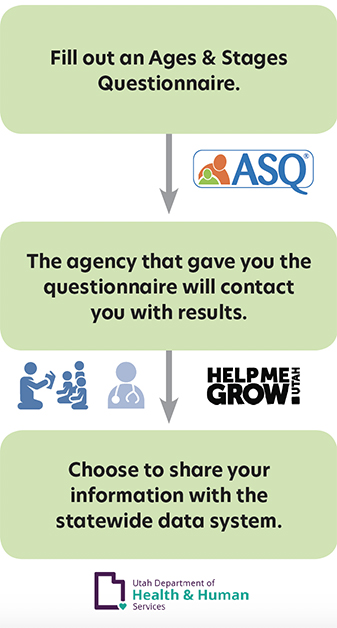- Office of Child Care
-
- Child Care Subsidies
- Subsidy Resources
- Quality Resources
- Care About Childcare
- Afterschool Providers
- ASQ Screening
- School Readiness
- Child Care Assistance
-
- ASQ Screening
- Other Resources
Celebrate the Stages with ASQ (Ages & Stages Questionnaire) Screenings
What is an ASQ screening?
ASQ, or the Ages & Stages Questionnaire, is a screener to check how a child is developing. Parents will answer if a child can complete different activities: “yes,” “sometimes” or “not yet.” They will also have the opportunity to share any concerns about the child. The questionnaire takes about 10 to 15 minutes to complete.
Why a Statewide Coordinated Developmental Screening System?
The Statewide Coordinated Developmental Screening System allows sharing of information so anyone who works with a child can, with a parent’s consent, have a better understanding of the child’s growth and development. This means we can all celebrate and develop a child’s strengths, while offering extra support in areas where it is needed.
How it Works
Parents will fill out an ASQ questionnaire about their child. Then, the agency that provided the parent with the questionnaire will provide results and the parent can choose whether to share the information in the statewide data system so any provider that works with the child can access the data.

FAQ
Will my data automatically be shared?
No. Your data will NOT be shared without your consent. You will choose whether or not to give consent and you can change your mind at any time.Is my data secure?
Yes. Strict data security and privacy rules are ensured through data sharing agreements with the Utah Department of Health and Human Services.What if my child has an area of concern?
The questionnaire is a screening tool, it does not provide a diagnosis. Your provider will help you decide on next steps, whether practicing some skills and rescreening is the best option, using another assessment tool with your child, or a referral to your pediatrician or other specialist.What if I already completed this questionnaire in the past?
The Ages & Stages Questionnaire is designed to be repeated at intervals throughout your child’s first years, in much the same way as well-child visits are often frequent at first, but decrease as your child grows. The American Academy of Pediatrics recommends that your child be screened at 2, 4, 6 and 9 months of age, and then every 6 months after theirb first birthday.How will I get my child’s results?
The agency that shared the screening link with you will contact you to discuss results. If you haven’t heard from them within a week, contact them directly.Who can see the data that I enter?
Only people to whom the parent gives permission can see identifiable information about the child. Account holders will only see information about the children they screen inside their program. Parents may give permission to other providers, including pediatricians or other health care professionals, who will access information about a child through other web portals or electronic health records.How is parental consent received?
When the parent follows the link to begin the online screening, they consent to do the screening online and share that information with their provider. They are also asked to consent to sharing the data with the Utah Department of Health and other providers. Their consent and date of consent is recorded in the online system. If the parent does a paper screener or the provider chooses to enter the screening manually into the online system, the provider is responsible to ensure consent is received for screening and data sharing.I don’t want to screen, but it would be useful to see screening data. Is that possible?
Yes, providers can request access through the CHARM web portal or for an EMR interface. Please contact occ@utah.gov for more information.How can I receive a free ASQ Online account through the statewide program?
If you are interested in participating, please contact occ@utah.gov to begin the training and onboarding process.More information is at www.agesandstages.com/ut.